
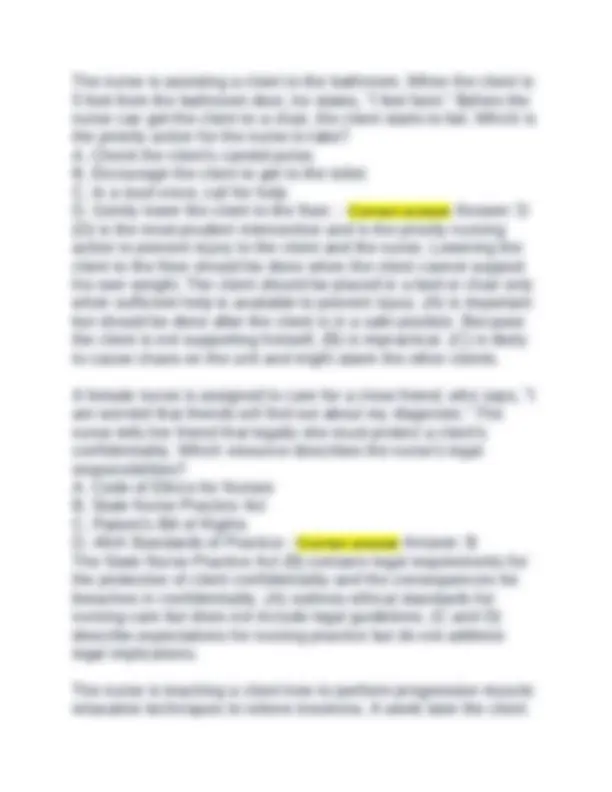
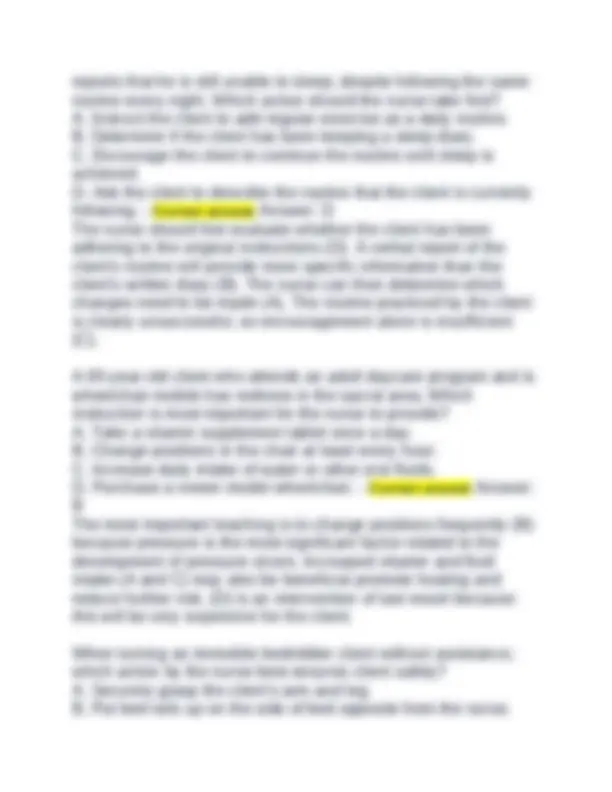
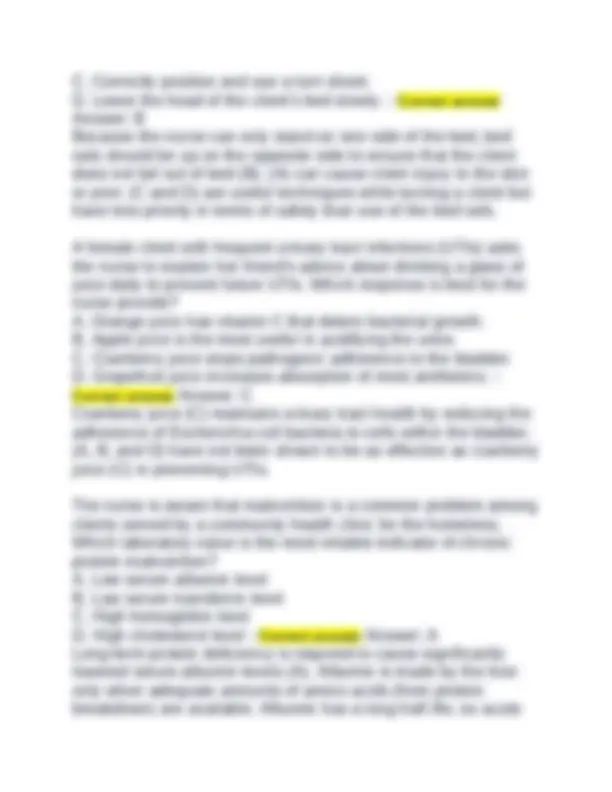
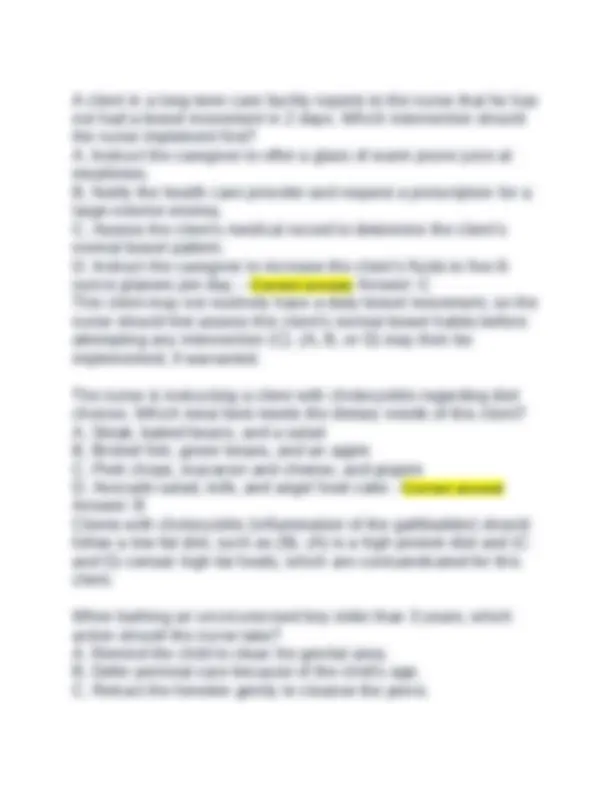
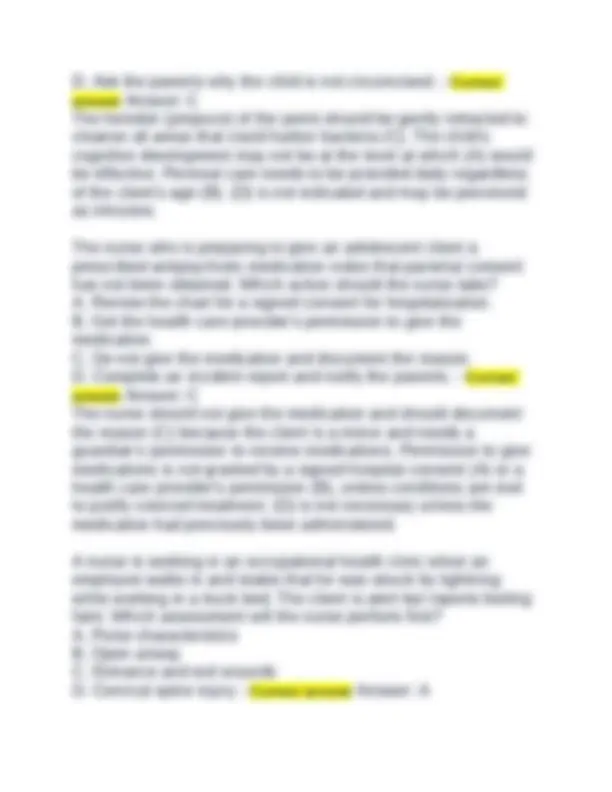
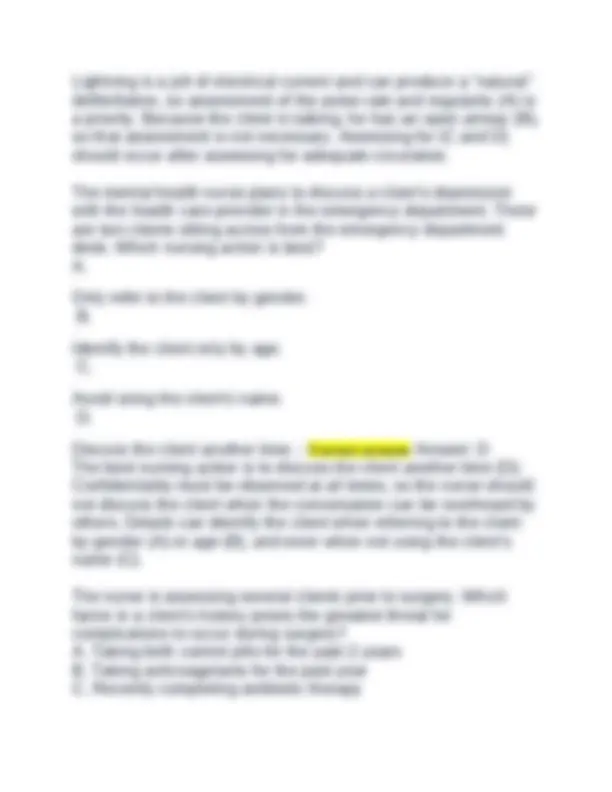
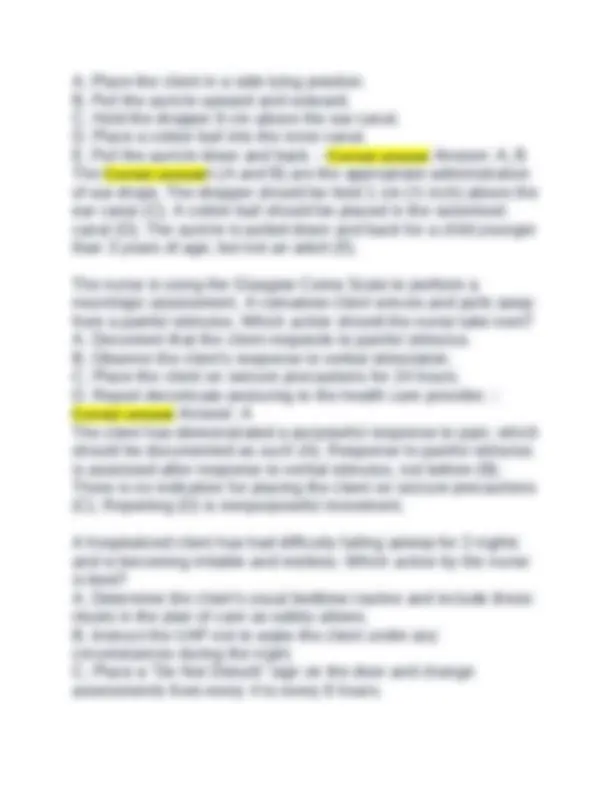
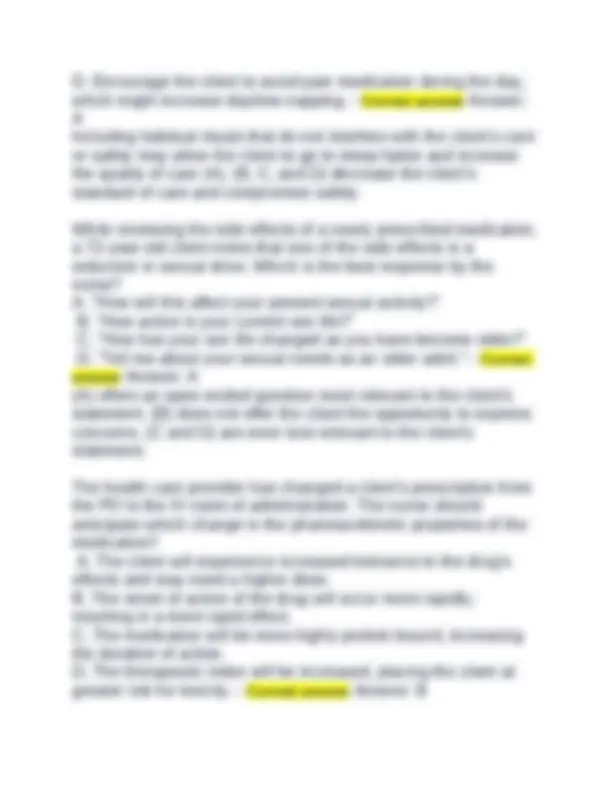
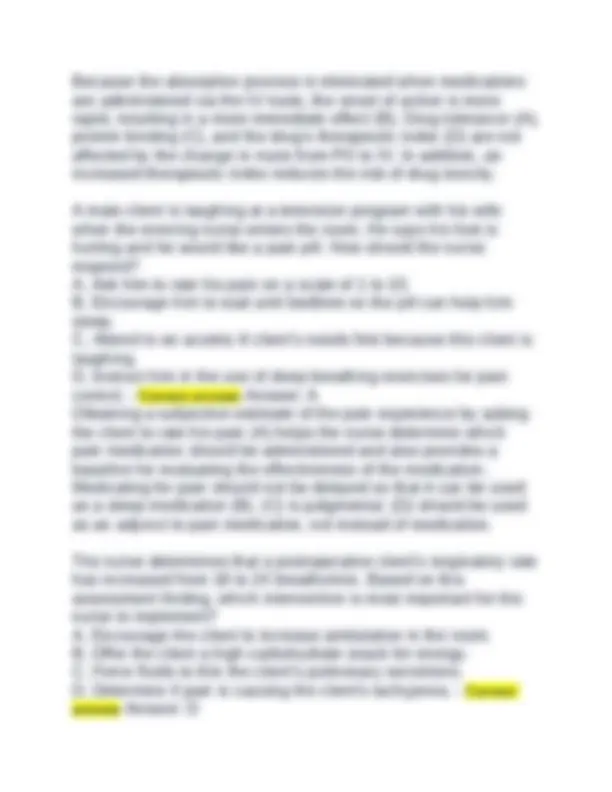
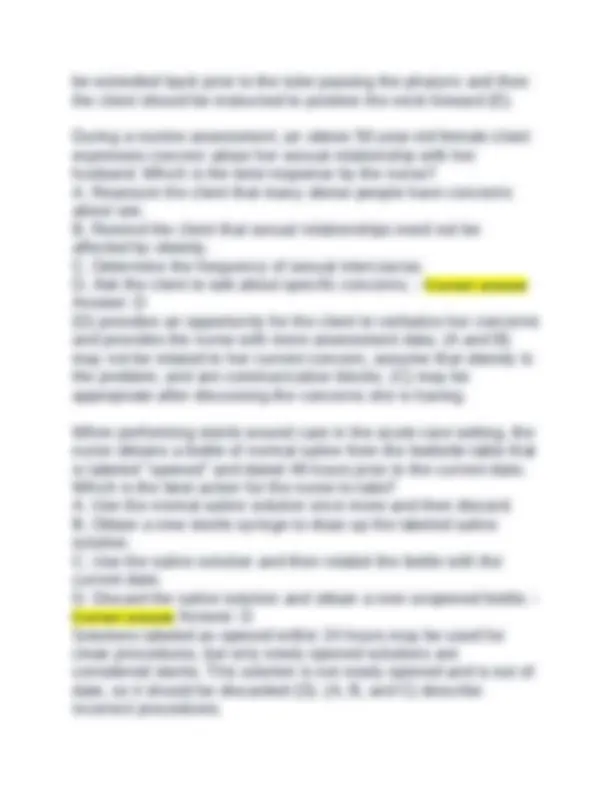
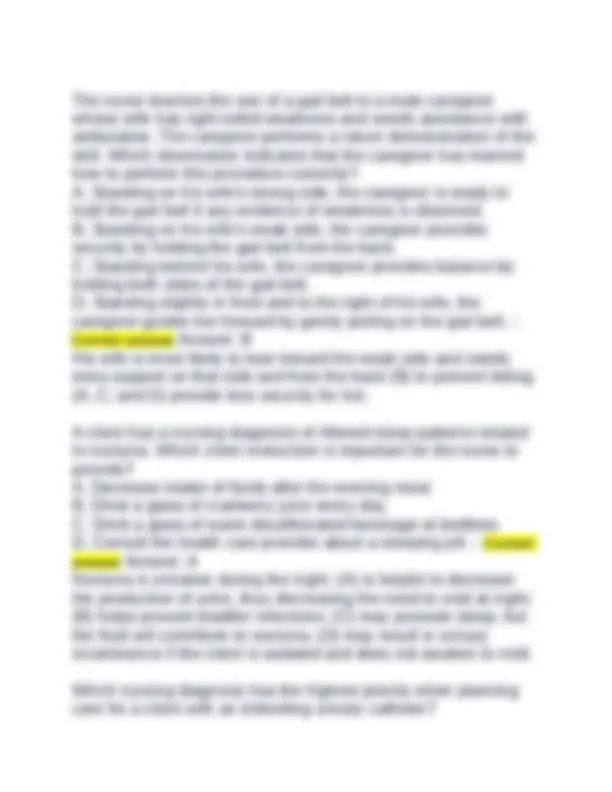
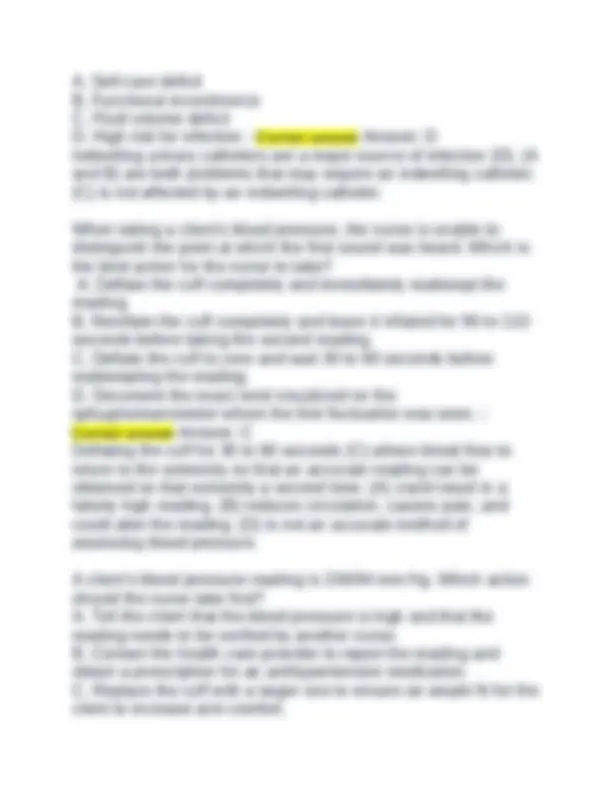
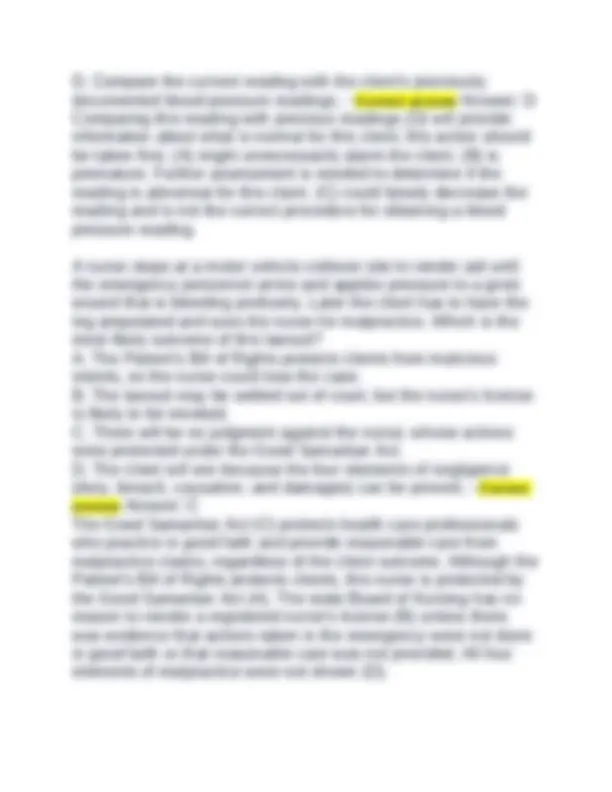
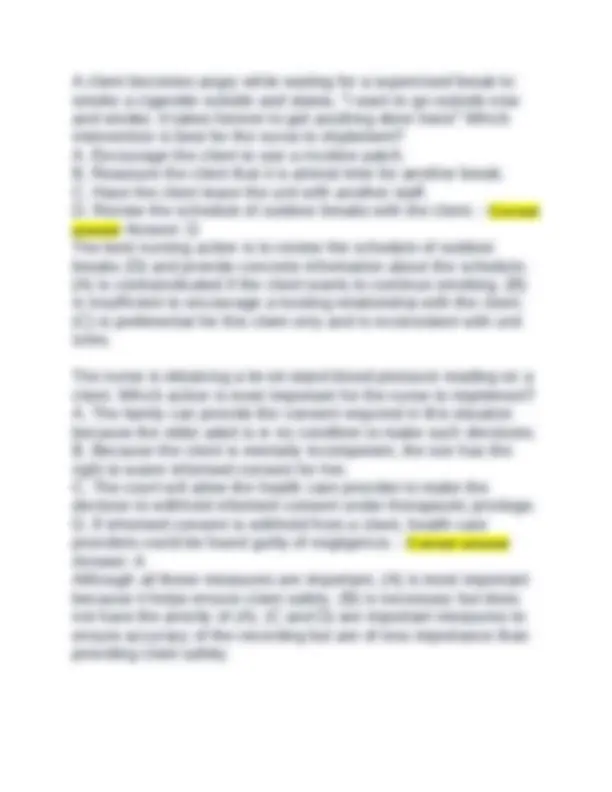
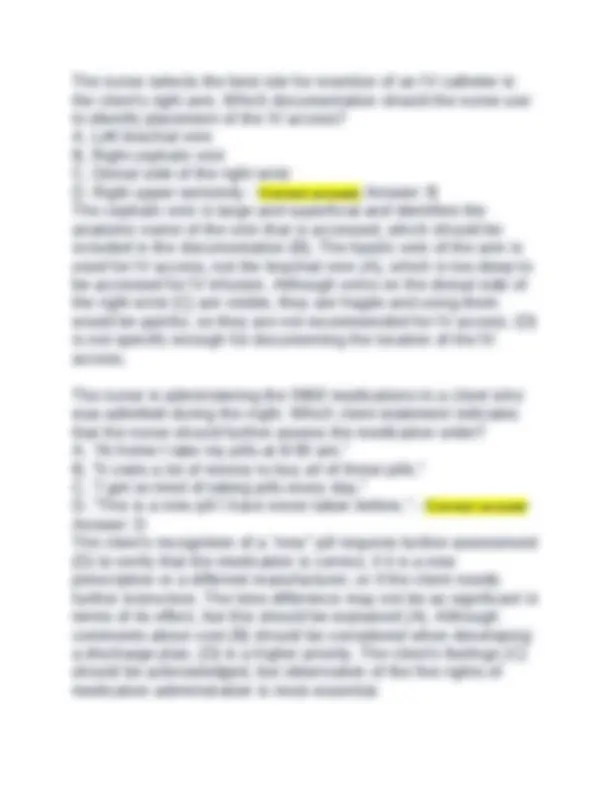
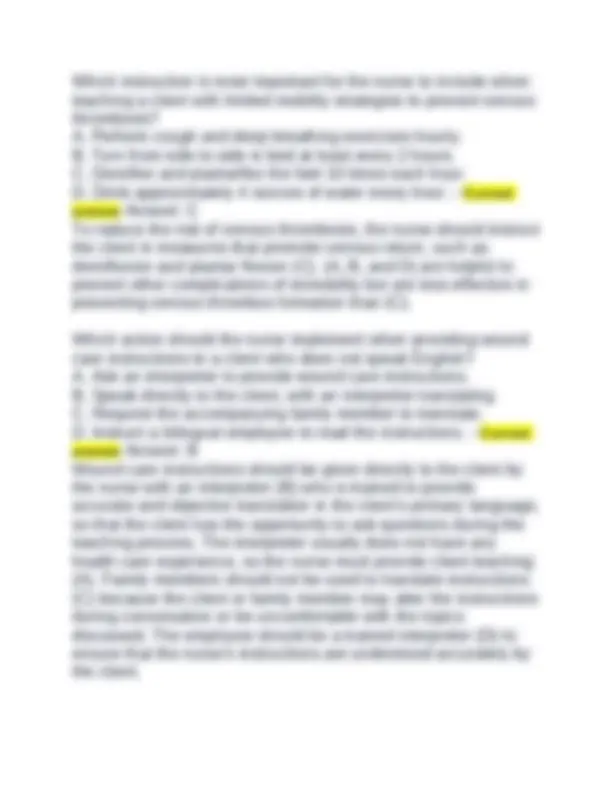
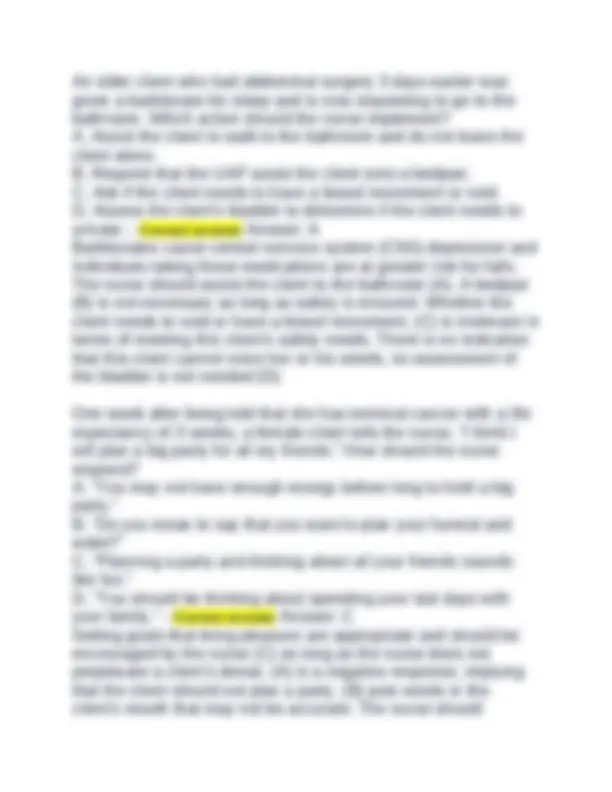
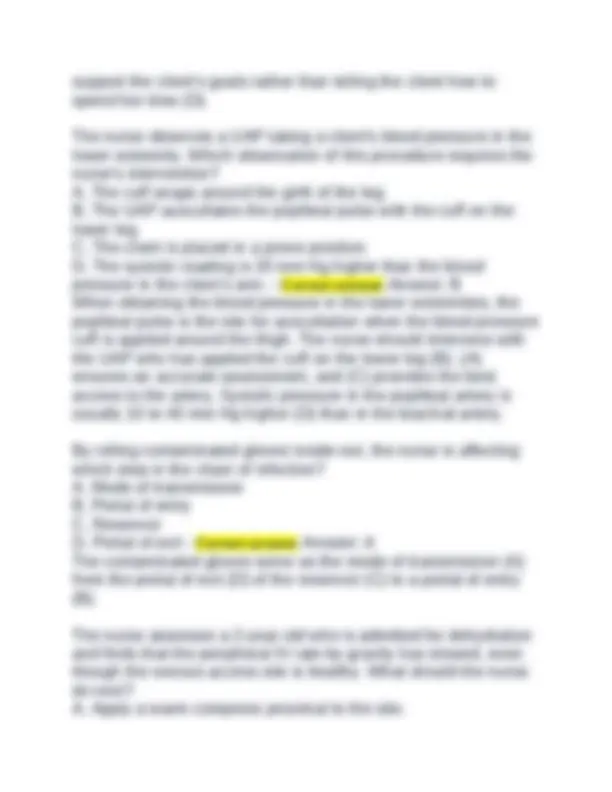
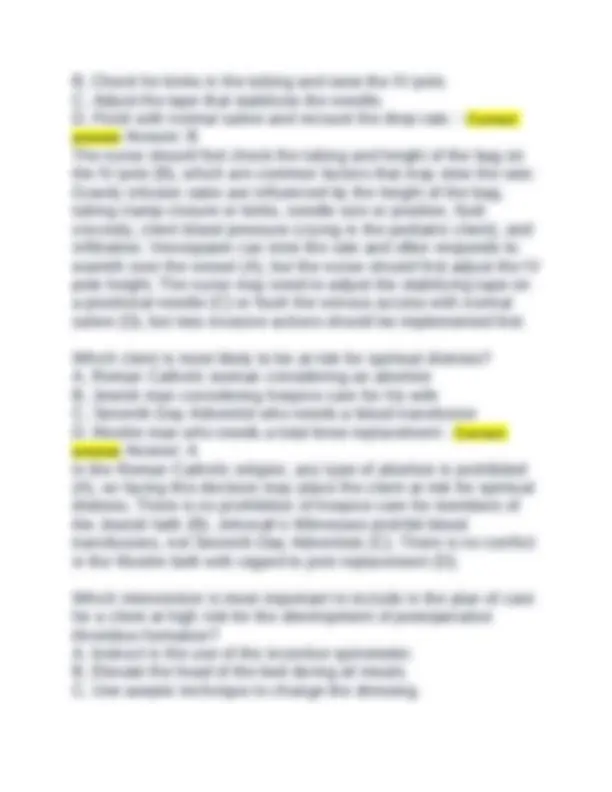
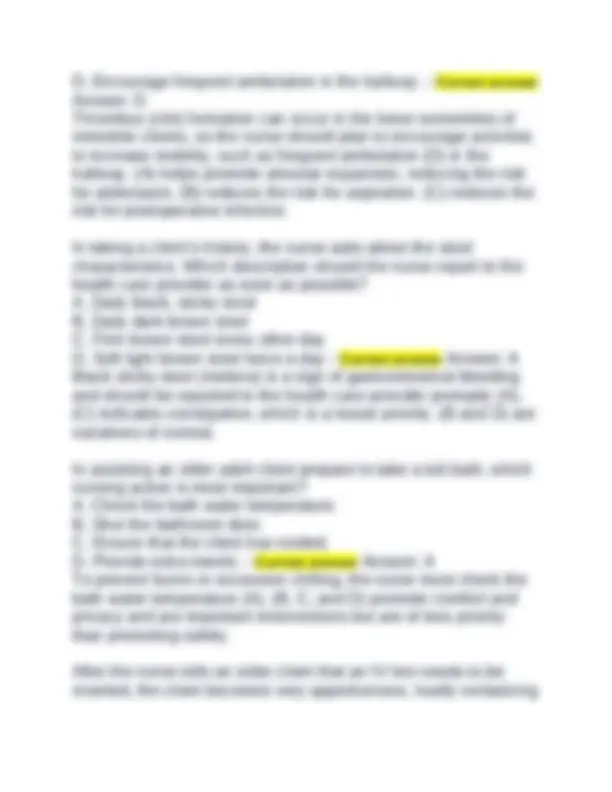
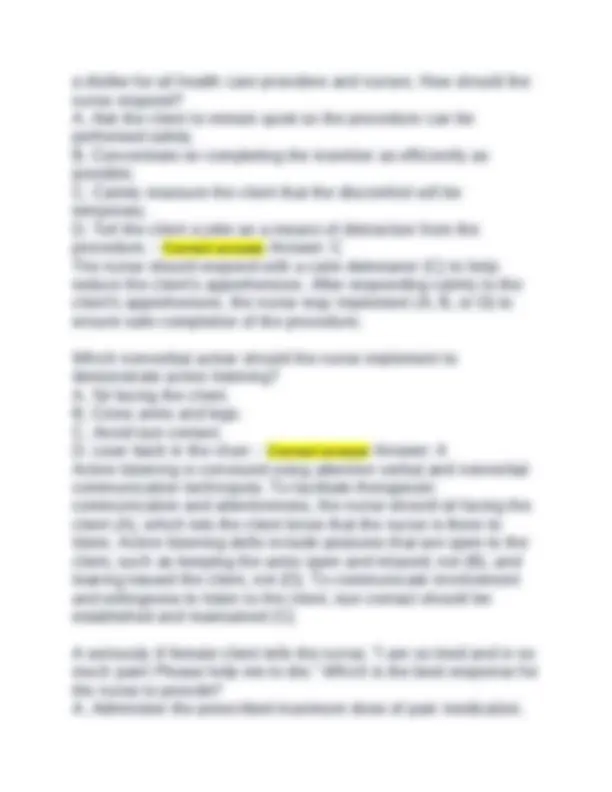
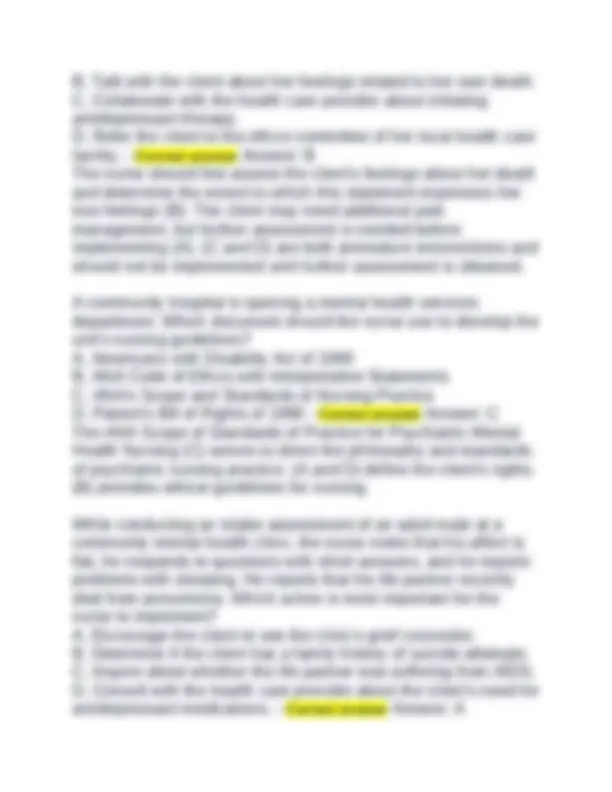
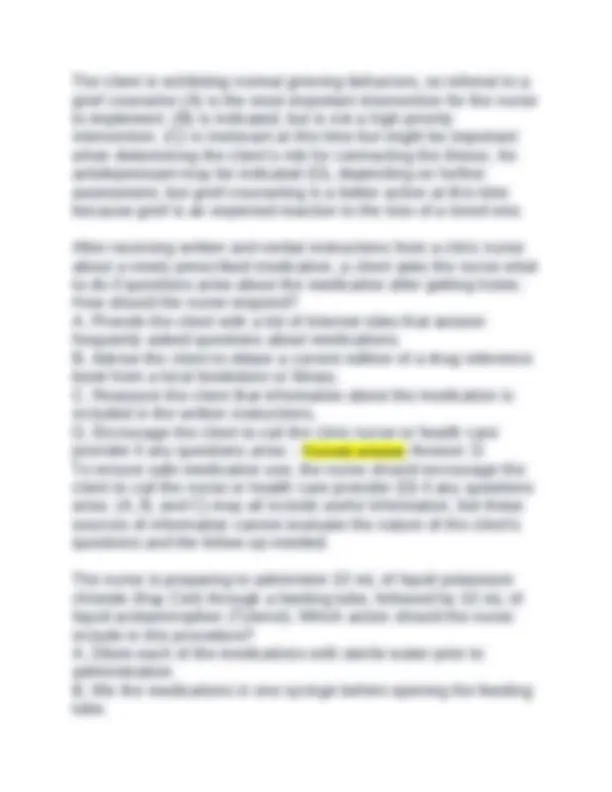
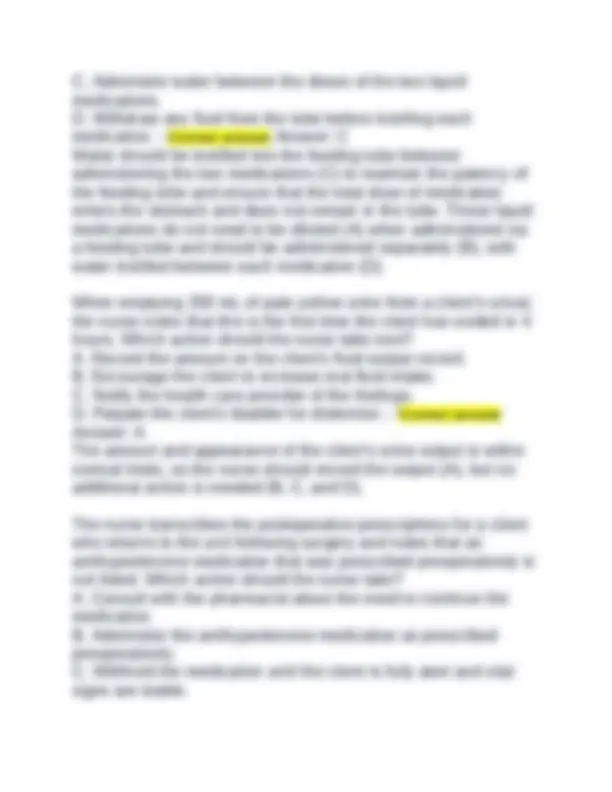
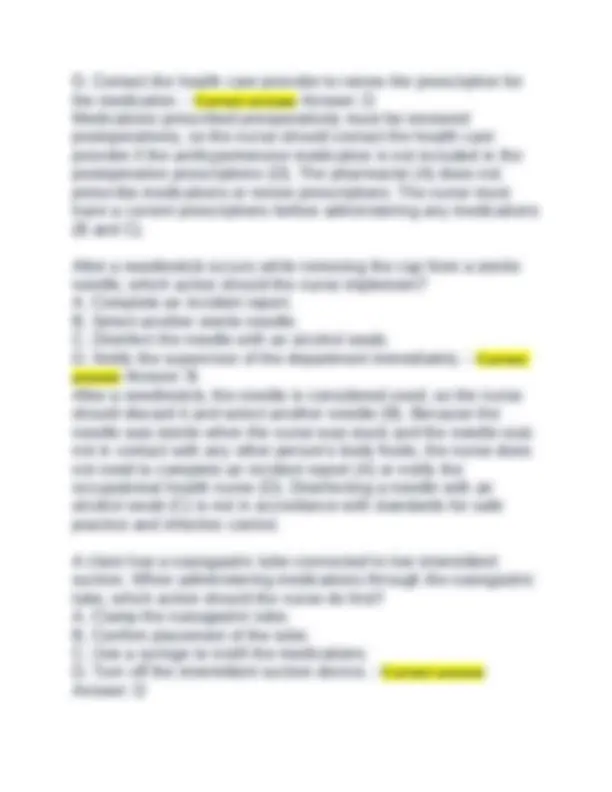
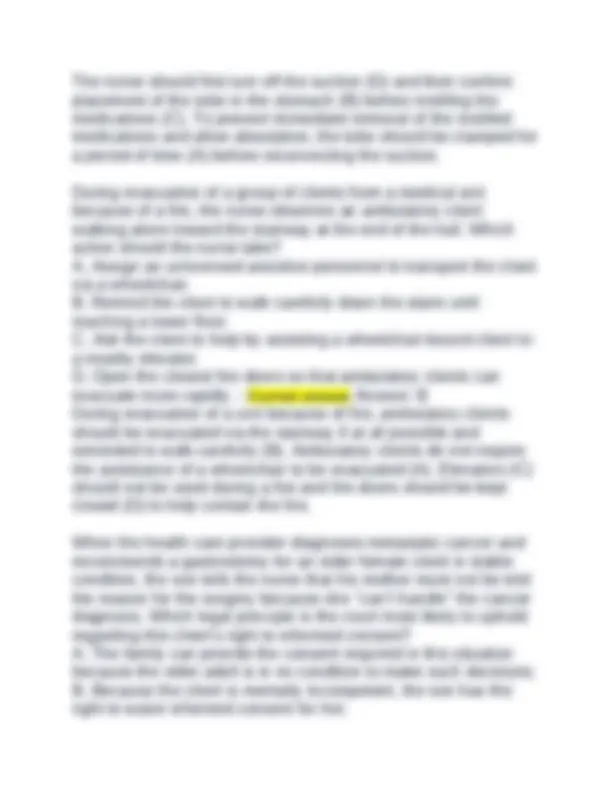
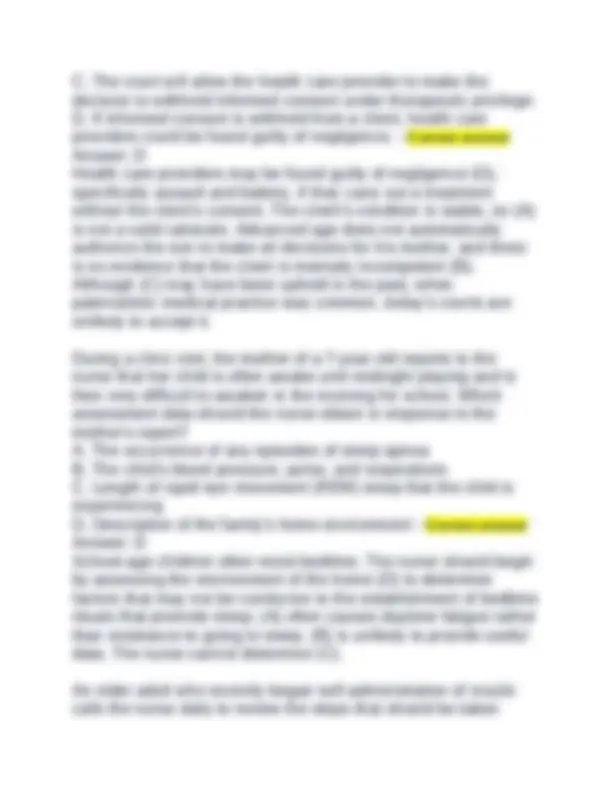
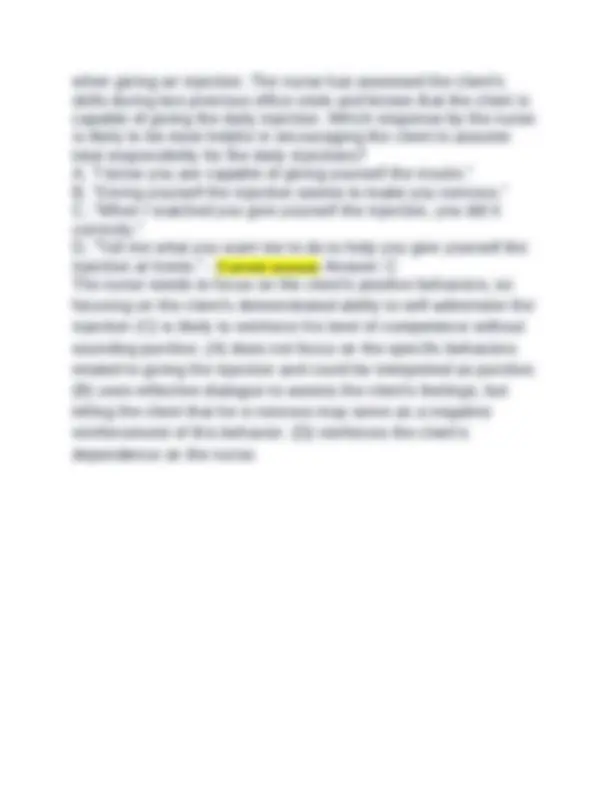


Study with the several resources on Docsity

Earn points by helping other students or get them with a premium plan


Prepare for your exams
Study with the several resources on Docsity

Earn points to download
Earn points by helping other students or get them with a premium plan
Community
Ask the community for help and clear up your study doubts
Discover the best universities in your country according to Docsity users
Free resources
Download our free guides on studying techniques, anxiety management strategies, and thesis advice from Docsity tutors
Evolve HESI Fundamentals Practice Questions and Answers. Evolve HESI Fundamentals Practice Questions and Answers.
Typology: Exams
1 / 36

This page cannot be seen from the preview
Don't miss anything!





























Urinary catheterization is prescribed for a postoperative female client who has been unable to void for 8 hours. The nurse inserts the catheter, but no urine is seen in the tubing. Which action will the nurse take next? A. Clamp the catheter and recheck it in 60 minutes. B. Pull the catheter back 3 inches and redirect upward. C. Leave the catheter in place and reattempt with another catheter. D. Notify the health care provider of a possible obstruction. - Correct answer Answer: C It is likely that the first catheter is in the vagina, rather than the bladder. Leaving the first catheter in place will help locate the meatus when attempting the second catheterization (C). The client should have at least 240 mL of urine after 8 hours. (A) does not resolve the problem. (B) will not change the location of the catheter unless it is completely removed, in which case a new catheter must be used. There is no evidence of a urinary tract obstruction if the catheter could be easily inserted (D). The nurse is teaching an obese client, newly diagnosed with arteriosclerosis, about reducing the risk of a heart attack or stroke. Which health promotion brochure is most important for the nurse to provide to this client? A. "Monitoring Your Blood Pressure at Home" B. "Smoking Cessation as a Lifelong Commitment" C. "Decreasing Cholesterol Levels Through Diet" D. "Stress Management for a Healthier You" - Correct answer Answer: C A health promotion brochure about decreasing cholesterol (C) is most important to provide this client, because the most significant
risk factor contributing to development of arteriosclerosis is excess dietary fat, particularly saturated fat and cholesterol. (A) does not address the underlying causes of arteriosclerosis. (B and D) are also important factors for reversing arteriosclerosis but are not as important as lowering cholesterol (C). Ten minutes after signing an operative permit for a fractured hip, an older client states, "The aliens will be coming to get me soon!" and falls asleep. Which action should the nurse implement next? A. Make the client comfortable and allow the client to sleep. B. Assess the client's neurologic status. C. Notify the surgeon about the comment. D. Ask the client's family to co-sign the operative permit. - Correct answer Answer: B This statement may indicate that the client is confused. Informed consent must be provided by a mentally competent individual, so the nurse should further assess the client's neurologic status (B) to be sure that the client understands and can legally provide consent for surgery. (A) does not provide sufficient follow-up. If the nurse determines that the client is confused, the surgeon must be notified (C) and permission obtained from the next of kin (D). The nurse-manager of a skilled nursing (chronic care) unit is instructing UAPs on ways to prevent complications of immobility. Which intervention should be included in this instruction? A. Perform range-of-motion exercises to prevent contractures. B. Decrease the client's fluid intake to prevent diarrhea. C. Massage the client's legs to reduce embolism occurrence. D. Turn the client from side to back every shift. - Correct answer Answer: A Performing range-of-motion exercises (A) is beneficial in reducing contractures around joints. (B, C, and D) are all potentially harmful practices that place the immobile client at risk of complications.
reports that he is still unable to sleep, despite following the same routine every night. Which action should the nurse take first? A. Instruct the client to add regular exercise as a daily routine. B. Determine if the client has been keeping a sleep diary. C. Encourage the client to continue the routine until sleep is achieved. D. Ask the client to describe the routine that the client is currently following. - Correct answer Answer: D The nurse should first evaluate whether the client has been adhering to the original instructions (D). A verbal report of the client's routine will provide more specific information than the client's written diary (B). The nurse can then determine which changes need to be made (A). The routine practiced by the client is clearly unsuccessful, so encouragement alone is insufficient (C). A 65-year-old client who attends an adult daycare program and is wheelchair-mobile has redness in the sacral area. Which instruction is most important for the nurse to provide? A. Take a vitamin supplement tablet once a day. B. Change positions in the chair at least every hour. C. Increase daily intake of water or other oral fluids. D. Purchase a newer model wheelchair. - Correct answer Answer: B The most important teaching is to change positions frequently (B) because pressure is the most significant factor related to the development of pressure ulcers. Increased vitamin and fluid intake (A and C) may also be beneficial promote healing and reduce further risk. (D) is an intervention of last resort because this will be very expensive for the client. When turning an immobile bedridden client without assistance, which action by the nurse best ensures client safety? A. Securely grasp the client's arm and leg. B. Put bed rails up on the side of bed opposite from the nurse.
C. Correctly position and use a turn sheet. D. Lower the head of the client's bed slowly. - Correct answer Answer: B Because the nurse can only stand on one side of the bed, bed rails should be up on the opposite side to ensure that the client does not fall out of bed (B). (A) can cause client injury to the skin or joint. (C and D) are useful techniques while turning a client but have less priority in terms of safety than use of the bed rails. A female client with frequent urinary tract infections (UTIs) asks the nurse to explain her friend's advice about drinking a glass of juice daily to prevent future UTIs. Which response is best for the nurse provide? A. Orange juice has vitamin C that deters bacterial growth. B. Apple juice is the most useful in acidifying the urine. C. Cranberry juice stops pathogens' adherence to the bladder. D. Grapefruit juice increases absorption of most antibiotics. - Correct answer Answer: C Cranberry juice (C) maintains urinary tract health by reducing the adherence of Escherichia coli bacteria to cells within the bladder. (A, B, and D) have not been shown to be as effective as cranberry juice (C) in preventing UTIs. The nurse is aware that malnutrition is a common problem among clients served by a community health clinic for the homeless. Which laboratory value is the most reliable indicator of chronic protein malnutrition? A. Low serum albumin level B. Low serum transferrin level C. High hemoglobin level D. High cholesterol level - Correct answer Answer: A Long-term protein deficiency is required to cause significantly lowered serum albumin levels (A). Albumin is made by the liver only when adequate amounts of amino acids (from protein breakdown) are available. Albumin has a long half-life, so acute
In completing a client's preoperative routine, the nurse finds that the operative permit is not signed. The client begins to ask more questions about the surgical procedure. Which action should the nurse take next? A. Witness the client's signature to the permit. B. Answer the client's questions about the surgery. C. Inform the surgeon that the operative permit is not signed and the client has questions about the surgery. D. Reassure the client that the surgeon will answer any questions before the anesthesia is administered. - Correct answer Answer: C The surgeon should be informed immediately that the permit is not signed (C). It is the surgeon's responsibility to explain the procedure to the cliesxnt and obtain the client's signature on the permit. Although the nurse can witness an operative permit (A), the procedure must first be explained by the health care provider or surgeon, including answering the client's questions (B). The client's questions should be addressed before the permit is signed (D). The nurse is preparing an older client for discharge. Which method is best for the nurse to use when evaluating the client's ability to perform a dressing change at home? A. Determine how the client feels about changing the dressing. B. Ask the client to describe the procedure in writing. C. Seek a family member's evaluation of the client's ability to change the dressing. D. Observe the client change the dressing unassisted. - Correct answer Answer: D Observing the client directly (D) will allow the nurse to determine if mastery of the skill has been obtained and provide an opportunity to affirm the skill. (A) may be therapeutic but will not provide an opportunity to evaluate the client's ability to perform the procedure. (B) may be threatening to an older client and will not determine his ability. (C) is not as effective as direct observation by the nurse.
A client in a long-term care facility reports to the nurse that he has not had a bowel movement in 2 days. Which intervention should the nurse implement first? A. Instruct the caregiver to offer a glass of warm prune juice at mealtimes. B. Notify the health care provider and request a prescription for a large-volume enema. C. Assess the client's medical record to determine the client's normal bowel pattern. D. Instruct the caregiver to increase the client's fluids to five 8- ounce glasses per day. - Correct answer Answer: C This client may not routinely have a daily bowel movement, so the nurse should first assess this client's normal bowel habits before attempting any intervention (C). (A, B, or D) may then be implemented, if warranted. The nurse is instructing a client with cholecystitis regarding diet choices. Which meal best meets the dietary needs of this client? A. Steak, baked beans, and a salad B. Broiled fish, green beans, and an apple C. Pork chops, macaroni and cheese, and grapes D. Avocado salad, milk, and angel food cake - Correct answer Answer: B Clients with cholecystitis (inflammation of the gallbladder) should follow a low-fat diet, such as (B). (A) is a high-protein diet and (C and D) contain high-fat foods, which are contraindicated for this client. When bathing an uncircumcised boy older than 3 years, which action should the nurse take? A. Remind the child to clean his genital area. B. Defer perineal care because of the child's age. C. Retract the foreskin gently to cleanse the penis.
Lightning is a jolt of electrical current and can produce a "natural" defibrillation, so assessment of the pulse rate and regularity (A) is a priority. Because the client is talking, he has an open airway (B), so that assessment is not necessary. Assessing for (C and D) should occur after assessing for adequate circulation. The mental health nurse plans to discuss a client's depression with the health care provider in the emergency department. There are two clients sitting across from the emergency department desk. Which nursing action is best? A. Only refer to the client by gender. B. Identify the client only by age. C. Avoid using the client's name. D. Discuss the client another time. - Correct answer Answer: D The best nursing action is to discuss the client another time (D). Confidentiality must be observed at all times, so the nurse should not discuss the client when the conversation can be overheard by others. Details can identify the client when referring to the client by gender (A) or age (B), and even when not using the client's name (C). The nurse is assessing several clients prior to surgery. Which factor in a client's history poses the greatest threat for complications to occur during surgery? A. Taking birth control pills for the past 2 years B. Taking anticoagulants for the past year C. Recently completing antibiotic therapy
D. Having taken laxatives PRN for the last 6 months - Correct answer Answer: B Anticoagulants (B) increase the risk for bleeding during surgery, which can pose a threat for the development of surgical complications. The health care provider should be informed that the client is taking these drugs. Although clients who take birth control pills (A) may be more susceptible to the development of thrombi, such problems usually occur postoperatively. A client with (C or D) is at less of a surgical risk than (B). When assisting a client from the bed to a chair, which procedure is best for the nurse to follow? A. Place the chair parallel to the bed, with its back toward the head of the bed and assist the client in moving to the chair. B. With the nurse's feet spread apart and knees aligned with the client's knees, stand and pivot the client into the chair. C. Assist the client to a standing position by gently lifting upward, underneath the axillae. D. Stand beside the client, place the client's arms around the nurse's neck, and gently move the client to the chair. - Correct answer Answer: B (B) describes the correct positioning of the nurse and affords the nurse a wide base of support while stabilizing the client's knees when assisting to a standing position. The chair should be placed at a 45-degree angle to the bed, with the back of the chair toward the head of the bed (A). Clients should never be lifted under the axillae (C); this could damage nerves and strain the nurse's back. The client should be instructed to use the arms of the chair and should never place his or her arms around the nurse's neck (D); this places undue stress on the nurse's neck and back and increases the risk for a fall. The nurse is instructing a client in the proper use of a metered- dose inhaler. Which instruction should the nurse provide the client to ensure the optimal benefits from the drug?
A. Place the client in a side-lying position. B. Pull the auricle upward and outward. C. Hold the dropper 6 cm above the ear canal. D. Place a cotton ball into the inner canal. E. Pull the auricle down and back. - Correct answer Answer: A, B The Correct answer s (A and B) are the appropriate administration of ear drops. The dropper should be held 1 cm (½ inch) above the ear canal (C). A cotton ball should be placed in the outermost canal (D). The auricle is pulled down and back for a child younger than 3 years of age, but not an adult (E). The nurse is using the Glasgow Coma Scale to perform a neurologic assessment. A comatose client winces and pulls away from a painful stimulus. Which action should the nurse take next? A. Document that the client responds to painful stimulus. B. Observe the client's response to verbal stimulation. C. Place the client on seizure precautions for 24 hours. D. Report decorticate posturing to the health care provider. - Correct answer Answer: A The client has demonstrated a purposeful response to pain, which should be documented as such (A). Response to painful stimulus is assessed after response to verbal stimulus, not before (B). There is no indication for placing the client on seizure precautions (C). Reporting (D) is nonpurposeful movement. A hospitalized client has had difficulty falling asleep for 2 nights and is becoming irritable and restless. Which action by the nurse is best? A. Determine the client's usual bedtime routine and include these rituals in the plan of care as safety allows. B. Instruct the UAP not to wake the client under any circumstances during the night. C. Place a "Do Not Disturb" sign on the door and change assessments from every 4 to every 8 hours.
D. Encourage the client to avoid pain medication during the day, which might increase daytime napping. - Correct answer Answer: A Including habitual rituals that do not interfere with the client's care or safety may allow the client to go to sleep faster and increase the quality of care (A). (B, C, and D) decrease the client's standard of care and compromise safety. While reviewing the side effects of a newly prescribed medication, a 72-year-old client notes that one of the side effects is a reduction in sexual drive. Which is the best response by the nurse? A. "How will this affect your present sexual activity?" B. "How active is your current sex life?" C. "How has your sex life changed as you have become older?" D. "Tell me about your sexual needs as an older adult." - Correct answer Answer: A (A) offers an open-ended question most relevant to the client's statement. (B) does not offer the client the opportunity to express concerns. (C and D) are even less relevant to the client's statement. The health care provider has changed a client's prescription from the PO to the IV route of administration. The nurse should anticipate which change in the pharmacokinetic properties of the medication? A. The client will experience increased tolerance to the drug's effects and may need a higher dose. B. The onset of action of the drug will occur more rapidly, resulting in a more rapid effect. C. The medication will be more highly protein-bound, increasing the duration of action. D. The therapeutic index will be increased, placing the client at greater risk for toxicity. - Correct answer Answer: B
Pain, anxiety, and increasing fluid accumulation in the lungs (D) can cause tachypnea (increased respiratory rate). Encouraging (A) when the respiratory rate is rising above normal limits puts the client at risk for further oxygen desaturation. (B) can increase the client's carbon metabolism, so an alternative source of energy, such as Pulmocare liquid supplement, should be offered instead. (C) could increase respiratory congestion in a client with a poorly functioning cardiopulmonary system, placing the client at risk of fluid overload. A 20-year-old female client with a noticeable body odor has refused to shower for the last 3 days. She states, "I have been told that it is harmful to bathe during my period." Which action should the nurse take first? A. Accept and document the client's wish to refrain from bathing. B. Offer to give the client a bed bath, avoiding the perineal area. C. Obtain written brochures about menstruation to give to the client. D. Teach the importance of personal hygiene during menstruation with the client. - Correct answer Answer: D Because a shower is most beneficial for the client in terms of hygiene, the client should receive teaching first (D), respecting any personal beliefs such as cultural or spiritual values. After client teaching, the client may still choose (A or B). Brochures reinforce the teaching (C). Based on the nursing diagnosis of Risk for infection, which intervention is best for the nurse to implement when providing care for an older incontinent client? A. Maintain standard precautions. B. Initiate contact isolation measures. C. Insert an indwelling urinary catheter. D. Instruct client in the use of adult diapers. - Correct answer Answer: A
The best action to decrease the risk of infection in vulnerable clients is hand washing (A). (B) is not necessary unless the client has an infection. (C) increases the risk of infection. (D) does not reduce the risk of infection. The nurse is counting a client's respiratory rate. During a 30- second interval, the nurse counts six respirations and the client coughs three times. In repeating the count for a second 30- second interval, the nurse counts eight respirations. Which respiratory rate should the nurse document? A. 14 B. 16 C. 17 D. 28 - Correct answer Answer: B The most accurate respiratory rate is the second count obtained by the nurse, which was not interrupted by coughing. Because it was counted for 30 seconds, the rate should be doubled (B). (A, C, and D) are inaccurate recordings. The nurse prepares to insert a nasogastric tube in a client with hyperemesis who is awake and alert. Which intervention(s) is(are) correct? (Select all that apply.) A. Place the client in a high Fowler's position. B. Help the patient assume a left side-lying position. C. Measure the tube from the tip of the nose to the umbilicus. D. Instruct the client to swallow after the tube has passed the pharynx. E. Assist the client in extending the neck back so the tube may enter the larynx. - Correct answer Answer: A, D (A and D) are the correct steps to follow during nasogastric intubation. Only the unconscious or obtunded client should be placed in a left side-lying position (B). The tube should be measured from the tip of the nose to behind the ear and then from behind the ear to the xiphoid process (C). The neck should only
The nurse teaches the use of a gait belt to a male caregiver whose wife has right-sided weakness and needs assistance with ambulation. The caregiver performs a return demonstration of the skill. Which observation indicates that the caregiver has learned how to perform this procedure correctly? A. Standing on his wife's strong side, the caregiver is ready to hold the gait belt if any evidence of weakness is observed. B. Standing on his wife's weak side, the caregiver provides security by holding the gait belt from the back. C. Standing behind his wife, the caregiver provides balance by holding both sides of the gait belt. D. Standing slightly in front and to the right of his wife, the caregiver guides her forward by gently pulling on the gait belt. - Correct answer Answer: B His wife is most likely to lean toward the weak side and needs extra support on that side and from the back (B) to prevent falling. (A, C, and D) provide less security for her. A client has a nursing diagnosis of Altered sleep patterns related to nocturia. Which client instruction is important for the nurse to provide? A. Decrease intake of fluids after the evening meal. B. Drink a glass of cranberry juice every day. C. Drink a glass of warm decaffeinated beverage at bedtime. D. Consult the health care provider about a sleeping pill. - Correct answer Answer: A Nocturia is urination during the night. (A) is helpful to decrease the production of urine, thus decreasing the need to void at night. (B) helps prevent bladder infections. (C) may promote sleep, but the fluid will contribute to nocturia. (D) may result in urinary incontinence if the client is sedated and does not awaken to void. Which nursing diagnosis has the highest priority when planning care for a client with an indwelling urinary catheter?
A. Self-care deficit B. Functional incontinence C. Fluid volume deficit D. High risk for infection - Correct answer Answer: D Indwelling urinary catheters are a major source of infection (D). (A and B) are both problems that may require an indwelling catheter. (C) is not affected by an indwelling catheter. When taking a client's blood pressure, the nurse is unable to distinguish the point at which the first sound was heard. Which is the best action for the nurse to take? A. Deflate the cuff completely and immediately reattempt the reading. B. Reinflate the cuff completely and leave it inflated for 90 to 110 seconds before taking the second reading. C. Deflate the cuff to zero and wait 30 to 60 seconds before reattempting the reading. D. Document the exact level visualized on the sphygmomanometer where the first fluctuation was seen. - Correct answer Answer: C Deflating the cuff for 30 to 60 seconds (C) allows blood flow to return to the extremity so that an accurate reading can be obtained on that extremity a second time. (A) could result in a falsely high reading. (B) reduces circulation, causes pain, and could alter the reading. (D) is not an accurate method of assessing blood pressure. A client's blood pressure reading is 156/94 mm Hg. Which action should the nurse take first? A. Tell the client that the blood pressure is high and that the reading needs to be verified by another nurse. B. Contact the health care provider to report the reading and obtain a prescription for an antihypertensive medication. C. Replace the cuff with a larger one to ensure an ample fit for the client to increase arm comfort.